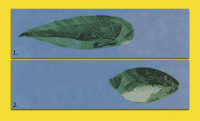|
Headless
Frog
Scientists
have created an embryo of a frog without a head, raising the prospect
of engineering headless human clones which could be used to grow
organs and tissues for transplant surgery. The headless frog  embryos
have not been allowed to live longer than a week, but the scientists
believe the technique could be adapted to grow human organs such
as hearts, kidneys, livers and the pancreas in an embryonic sac
living in an artificial womb. If human cloning becomes possible
and many scientists believe it is inevitable following the birth
of Dolly, the first adult sheep clone, the two breakthroughs could
be combined so that people requiring transplants could have organs
grown to order from their own cloned cells. Jonathan Slack, professor
of developmental biology at Bath University and a leading embryologist,
says he can now create headless frog embryos relatively easily
by manipulating certain genes. Using the technique, he has been
able to suppress not only development of a tadpole's head, but
also its trunk and tail. embryos
have not been allowed to live longer than a week, but the scientists
believe the technique could be adapted to grow human organs such
as hearts, kidneys, livers and the pancreas in an embryonic sac
living in an artificial womb. If human cloning becomes possible
and many scientists believe it is inevitable following the birth
of Dolly, the first adult sheep clone, the two breakthroughs could
be combined so that people requiring transplants could have organs
grown to order from their own cloned cells. Jonathan Slack, professor
of developmental biology at Bath University and a leading embryologist,
says he can now create headless frog embryos relatively easily
by manipulating certain genes. Using the technique, he has been
able to suppress not only development of a tadpole's head, but
also its trunk and tail.
|


 embryos
have not been allowed to live longer than a week, but the scientists
believe the technique could be adapted to grow human organs such
as hearts, kidneys, livers and the pancreas in an embryonic sac
living in an artificial womb. If human cloning becomes possible
and many scientists believe it is inevitable following the birth
of Dolly, the first adult sheep clone, the two breakthroughs could
be combined so that people requiring transplants could have organs
grown to order from their own cloned cells. Jonathan Slack, professor
of developmental biology at Bath University and a leading embryologist,
says he can now create headless frog embryos relatively easily
by manipulating certain genes. Using the technique, he has been
able to suppress not only development of a tadpole's head, but
also its trunk and tail.
embryos
have not been allowed to live longer than a week, but the scientists
believe the technique could be adapted to grow human organs such
as hearts, kidneys, livers and the pancreas in an embryonic sac
living in an artificial womb. If human cloning becomes possible
and many scientists believe it is inevitable following the birth
of Dolly, the first adult sheep clone, the two breakthroughs could
be combined so that people requiring transplants could have organs
grown to order from their own cloned cells. Jonathan Slack, professor
of developmental biology at Bath University and a leading embryologist,
says he can now create headless frog embryos relatively easily
by manipulating certain genes. Using the technique, he has been
able to suppress not only development of a tadpole's head, but
also its trunk and tail.